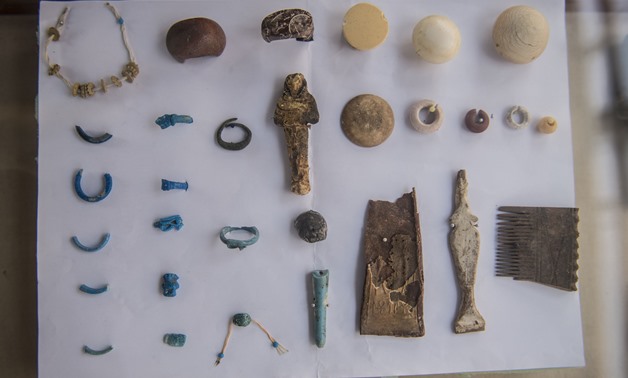
ornaments recovered at the site of a newly-uncovered ancient tomb for a goldsmith dedicated to the ancient Egyptian god Amun, in the Draa Abul Naga necropolis on the west bank of the ancient city of Luxor, which boasts ancient Egyptian temples and burial
CAIRO- 9 September 2017: A cemetery of Amun-Re’s goldsmith, Amenemhat (Kampp 390), dating back to the 18thdynasty, along with a Middle Kingdom burial shaft for a family, was discovered. The site is located in Draa Abul-Naga necropolis on Luxor's West Bank, announced Minister of Antiquities Khaled Anany on Saturday during a global press conference.
The newly-discovered cemetery was found by an Egyptian archaeological mission headed by Mostafa Waziri, head of the Luxor antiquities sector. The cemetery contains an entrance located in the courtyard of another Middle Kingdom tomb, Kampp 150.
 small funerary statues carved in wood, clay and limestone recovered at the site of a newly-uncovered ancient tomb for a goldsmith dedicated to the ancient Egyptian god Amun, in the Draa Abul Naga necropolis on the west bank of the ancient city of Luxor, which boasts ancient Egyptian temples and burial grounds - AFP
small funerary statues carved in wood, clay and limestone recovered at the site of a newly-uncovered ancient tomb for a goldsmith dedicated to the ancient Egyptian god Amun, in the Draa Abul Naga necropolis on the west bank of the ancient city of Luxor, which boasts ancient Egyptian temples and burial grounds - AFP
The entrance leads to a room that contains a niche with a duo statue depicting the tomb owner, who was jewellery maker, and his wife. The statue shows Amenemhat sitting on a high-backed chair beside his wife, who wears a long dress and wig.
Between their legs stands a small figure of their son. The cemetery has two burial shafts. The main burial shaft is seven meters deep and has a collection of mummies, sarcophagi and funerary masks carved in wood, along with a collection of ushabti statues.
 Egyptian archaeologist restoring a wooden sacrophagus at a newly-uncovered ancient tomb for a goldsmith dedicated to the ancient Egyptian god Amun, in the Draa Abul Naga necropolis on the west bank of the ancient city of Luxor, which boasts ancient Egyptian temples and burial grounds - AFP
Egyptian archaeologist restoring a wooden sacrophagus at a newly-uncovered ancient tomb for a goldsmith dedicated to the ancient Egyptian god Amun, in the Draa Abul Naga necropolis on the west bank of the ancient city of Luxor, which boasts ancient Egyptian temples and burial grounds - AFP
The second shaft contains a collection of 21st and 22nd dynasty sarcophagi subject to deterioration during the Late Period.
In the open courtyard, the mission stumbled upon a collection of Middle Kingdom burial shafts, where a family burial of a woman and her two children was unearthed. It includes two wooden coffins with mummies and a collection of head-rests. One of the coffins contains the head-rest of the deceased woman, as well as a group of pottery vessels.
 skulls and a wooden sacrophagus at a newly-uncovered ancient tomb for a goldsmith dedicated to the ancient Egyptian god Amun, in the Draa Abul Naga necropolis on the west bank of the ancient city of Luxor, which boasts ancient Egyptian temples and burial grounds- AFP
skulls and a wooden sacrophagus at a newly-uncovered ancient tomb for a goldsmith dedicated to the ancient Egyptian god Amun, in the Draa Abul Naga necropolis on the west bank of the ancient city of Luxor, which boasts ancient Egyptian temples and burial grounds- AFP
The mummies of both their sons were found in good condition. The Egyptian mission also discovered limestone remains of an offering table, four wooden sarcophagi partly damaged and decorated with hieroglyphic text, scenes of different ancient Egyptian gods, and a sandstone duo statue of a gold trader in King Tuthmose III’s temple named “Mah”.
A group of 150 small ushabti statues carved in faience, wood, burned clay, limestone and mud brick were also found. The mission also discovered a collection of 50 funerary cones. Waziry announced that the work in this cemetery is not over yet, as the coming period is expected to witness the discovery of several pharaonic tombs and the excavation work will continue in the coming months.
 Egyptian labourer unearthing skulls and bone remains at a newly-uncovered ancient tomb for a goldsmith dedicated to the ancient Egyptian god Amun, in the Draa Abul Naga necropolis on the west bank of the ancient city of Luxor, which boasts ancient Egyptian temples and burial grounds - AFP
Egyptian labourer unearthing skulls and bone remains at a newly-uncovered ancient tomb for a goldsmith dedicated to the ancient Egyptian god Amun, in the Draa Abul Naga necropolis on the west bank of the ancient city of Luxor, which boasts ancient Egyptian temples and burial grounds - AFP
‘’The new discovered cemetery has taken the archaeologists to the entrances of new tombs that are about to be discovered in the future,’’ recounted Mostafa El Waziri, the head of the Luxor antiquities sector during the conference.
Waziri said that he is confident that the new cemetery, located in the western bank in Luxor, will be stronger and more historic than the "Osrahat cemetery," which was announced in April. The press conference was also attended by Governor of Luxor Mohamed Badr, Mostafa Waziri, a large number of foreign and Egyptian media, the ambassador of Cyprus, and some members of Parliament.





Comments
Leave a Comment